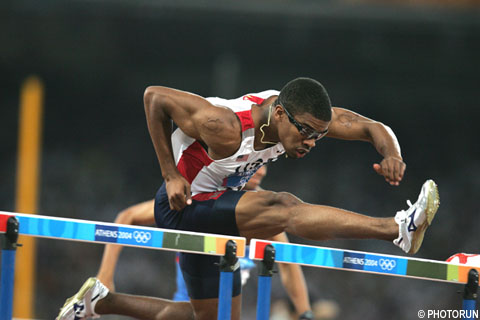“Keep your head up, use your eyes, then pursue.” –Joe Paterno
In a couple of previous articles on this website, I have discussed the importance of keeping your eyes on the crossbar while hurdling. In this article, I want to clarify and expand upon that point, based on a few observations I’ve picked up on recently.
Ideally, you want to keep your eyes on the crossbar of the hurdle you’re about to clear until you get one step away from that hurdle. Then you want to get your eyes on the next one. In other words, for the traditional eight-stepper to the first hurdle, try to get your eyes on the crossbar by the third step, keep them there through the seventh step, then, at the eighth step, get your eyes off the first hurdle, and immediately get them on the second one. For all succeeding hurdles through the ninth one, keep your eyes on the hurdle you’re about to clear all the way through to the third step, then, at the third step, get your eyes on the next hurdle. At the third step of the tenth hurdle, get your eyes on the finish line.
You’ll be surprised at how much using your eyes in the above manner helps you to develop and maintain a hurdling rhythm. What happens is, your eyes settle into a rhythm that matches the rhythm of your legs. At each hurdle, at that third step, the lead-leg knee lifts into its attack of the hurdle as the eyes simultaneously lift above the hurdle you’re clearing to the hurdle you’re going to clear next. What you’ll find is, even at hyper-speeds, when it feels like the hurdles are rushing up at you, your eyes will help you to feel like you can manage the hurdles without needing to compromise your aggression. You learn to trust your speed. Also, you tend to zigzag less in the lane less, as the eyes, along with the lead-leg knee, serve to keep you sprinting in a straight line. In addition, you’ll find that your acceleration off each hurdle will improve.

Two-time Olympic silver medallist Terrence Trammell gets his eyes on the next hurdle.
Keeping your eyes on the crossbars of hurdles keeps your eyes from lazily or unconsciously floating upward, or laterally, to where the competition is. Stop trying to sneak a peek to your left or your right to make sure another hurdler isn’t creeping up on you! There is so much going on in the course of a hurdle race that can distract you, that can break your concentration, that you have to have some kind of method in place that allows you to maintain focus when the mind feels inclined to give in to its natural tendency to wander or redirect its attention. As we all know, when the mind wanders, the eyes follow. That’s when hurdles get smashed, and winnable races get lost.
Focusing on how to use your eyes to guide you through a hurdle race is not necessarily something that a beginner wants to do. First things should come first, which means you should start by mastering lead-leg and trail-leg mechanics, and maintaining harmonious synchronicity between the arms and legs. In a race, it takes a lot of mental discipline to stay in the mode of clearing the hurdle in front of you, especially if you’ve fallen behind and are trying to catch up. As we all know, it’s when a hurdler is in catch-up mode that he or she will press and start hitting hurdles. Think of each hurdle as a finish line, and use your eyes as a means of confirming that concept. In a sense, when you’re hurdling over ten hurdles, you’re constantly sprinting through one finish line and to the next finish line. The actual finish line is actually the eleventh one.
© 2005 Steve McGill
